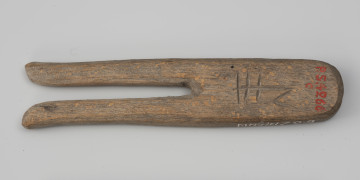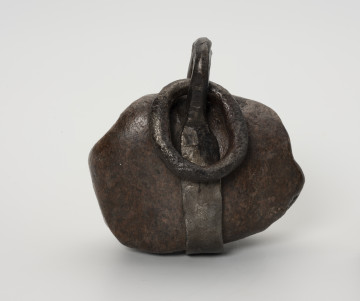
Buckle with ownership mark
1890 — 1950
National Museum in Szczecin
Part of the collection: Traditional fishing
Weights are an essential accessory in the work of fishermen. In the folk dialect of some regions they were called a “gręza” (a sinker). They serve to ballast the lower edges of set nets such as manca, gillnets, trammel nets, which do not change their position during fishing. The correct positioning of the weights and floats, which keep the upper parts of the net on the water's surface, is crucial to the effectiveness of the catch. In the past, it was common for fishermen to make floats themselves, for their own use. They used various kinds of easily accessible materials. The use of stone and fire-baked clay is documented in archaeological sources as far back as the end of the Neolithic period. In modern times, iron, lead, concrete and cement are also used to produce weights. The featured weight from the collection of the Pomeranian Ethnography Department of the National Museum in Szczecin dates back to the turn of the 19th and 20th centuries, from the Szczecin district of Skolwin (until 1945 German: Stolzenhagen). It was built from heavy stone surrounded by a wrought iron clamp and fitted with a link for attaching it to a net. It was used by German fishermen most likely while fishing in the Szczecin Lagoon and Lake Dąbie. Agnieszka Słowińska
Object type
fishing net weight
Technique
kowalska / kucie
Material
stone, wrought iron
Origin / acquisition method
donation
Creation time / dating
Creation / finding place
Owner
Muzeum Narodowe w Szczecinie
Identification number
Location / status

1890 — 1950
National Museum in Szczecin

1940 — 1949
National Museum in Szczecin

1901 — 1945
National Museum in Szczecin
DISCOVER this TOPIC
National Museum in Lublin
DISCOVER this PATH
Educational path